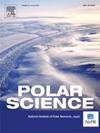基于瑞利波椭圆度、多模面波和扩散波纵横谱比联合反演的东南极洲drning Maud地Maitri站横波速度结构
IF 2
4区 地球科学
Q3 ECOLOGY
引用次数: 0
摘要
为了了解冈瓦纳超大陆的演化过程,研究了东南极洲一个稳定的克拉通块体——Dronning Maud Land。本文研究了Rayleigh波椭圆率(RWE)和水平-垂直谱比(HVSR)在假设环境噪声场(ANF)的等分相位或扩散场假设(DFA)的情况下评估浅层地壳剪切速度的能力。利用印度位于DML的Maitri (MAI)永久宽带地震台站的数据,我们分析了2013年至2017年在0.02 Hz (50 s周期)至10 Hz (0.1 s周期)频率范围内的地壳和浅层剪切速度,不包括扰动期。采用两种不同的方法提取RWE,并比较了RWE和HVSR的几何平均值。RWE和HVSR曲线都显示出稳定的形状,低频峰值在~ 0.03 Hz左右,表明深度速度对比。在~ 6 Hz附近观测到一个峰值,但变化很大,峰值幅度较小,可能是由于冰厚或永久冻土的变化。利用MAI先前接收函数(RF)研究的参考剪切速度模型,我们对地壳速度剖面的RWE和HVSR (DFA)曲线进行非线性反演,反演范围为~ 50 km。利用多模态面波频散曲线联合反演可以最大限度地减少反演的非唯一性,与射频模型的拟合效果较好。导出的剪切速度模型显示,在30-35 km深度(可能是莫霍)有明显的速度对比,在150-800 m深度有一个浅的低速沉积层,在~ 3 km深度可能有一个高速致密层。本文章由计算机程序翻译,如有差异,请以英文原文为准。
Shear Wave Velocity Structure beneath Maitri station in Dronning Maud Land, East Antarctica from Joint Inversions of Rayleigh Wave Ellipticity, Multimode Surface Waves and Diffused Wave Horizontal-to-Vertical Spectral Ratios
Dronning Maud Land (DML) in East Antarctica, a stable cratonic block, is explored to understand the evolution of the Gondwana supercontinent. This study investigates the capabilities of the Rayleigh Wave Ellipticity (RWE) and the horizontal-to-vertical spectral ratio (HVSR), assuming equipartitioned phases or diffused field assumption (DFA) of ambient noise field (ANF), to assess shallow crustal shear velocity. Using data from India's permanent broadband seismic station at Maitri (MAI) in DML, we analyse the crustal and shallow shear velocity in the frequency range 0.02 Hz (50 s period) to 10 Hz (0.1 s period) from 2013 to 2017, excluding disturbance periods. The RWE is extracted with two different methods, and the geometric mean of RWE and HVSR is compared. Both RWE and HVSR curves show a stable shape with a low-frequency peak around ∼0.03 Hz, indicating a deep velocity contrast. A peak near ∼6 Hz is observed but with wide variations and smaller peak amplitudes, possibly due to ice thickness or permafrost variations. Using a reference shear velocity model from a previous receiver function (RF) study at MAI, we apply non-linear inversions on RWE and HVSR (DFA) curves for crustal velocity profiles up to ∼50 km. Joint inversions with multimodal surface-wave dispersion curves minimize inversion non-uniqueness, yielding a good match with RF model. The derived shear velocity models show a distinct velocity contrast at 30–35 km depth (possibly the Moho) and a shallow, low-velocity sedimentary layer at 150–800 m depth, with a possible high-velocity, densified layer at ∼3 km depth.
求助全文
通过发布文献求助,成功后即可免费获取论文全文。
去求助
来源期刊

Polar Science
ECOLOGY-GEOSCIENCES, MULTIDISCIPLINARY
CiteScore
3.90
自引率
5.60%
发文量
46
期刊介绍:
Polar Science is an international, peer-reviewed quarterly journal. It is dedicated to publishing original research articles for sciences relating to the polar regions of the Earth and other planets. Polar Science aims to cover 15 disciplines which are listed below; they cover most aspects of physical sciences, geosciences and life sciences, together with engineering and social sciences. Articles should attract the interest of broad polar science communities, and not be limited to the interests of those who work under specific research subjects. Polar Science also has an Open Archive whereby published articles are made freely available from ScienceDirect after an embargo period of 24 months from the date of publication.
- Space and upper atmosphere physics
- Atmospheric science/climatology
- Glaciology
- Oceanography/sea ice studies
- Geology/petrology
- Solid earth geophysics/seismology
- Marine Earth science
- Geomorphology/Cenozoic-Quaternary geology
- Meteoritics
- Terrestrial biology
- Marine biology
- Animal ecology
- Environment
- Polar Engineering
- Humanities and social sciences.
 求助内容:
求助内容: 应助结果提醒方式:
应助结果提醒方式:


